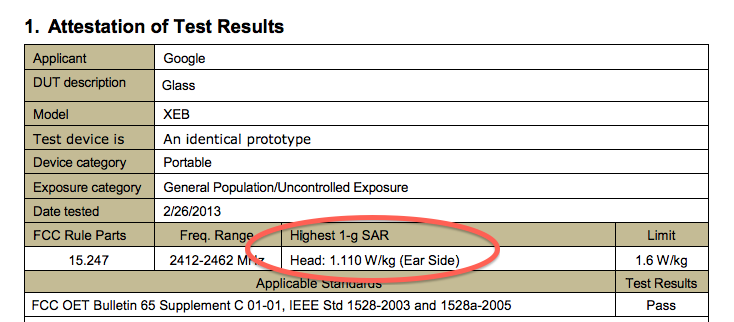Well, that didn’t take long, did it? Even before the devices have gone on sale, and when only a dozen people are actually using them, we’re already seeing scare stories about the dangers of radiation from Google Glass.
But according to Tawkon, which specialises in tracking cell phone radiation, we won’t know how much cellular radiation Glass emits until we can test them in the wild in sufficiently large numbers – and that won’t happen until they go on sale.
We do know that the radiation levels will have to remain under strict FCC limits for the devices to go on sale.
Responding to a question on Quora, Tawkon says a Google Glass prototype submitted for FCC testing was found to have an SAR of 1.1W/Kg (Watts per Kilogram).
Radiation from smartphones is gauged in what’s called “Specific Absorption Rate,” which the measurement of the amount of power/Watts (in this case radiation) absorbed per mass of tissue/kilograms (the W/kg number above).
In the US devices can’t emit more than 1.6W/Kg, and in Europe the amount is slightly higher at 2W/Kg.
If we compare them to the latest smartphones it appears that Google Glass produces quite a large amount of radiation. We know that Apple’s iPhone emits 1.18W/Kg while Samsung’s Galaxy Note II throws out 0.171 W/Kg.
But this doesn’t tell the full story. The iPhone appears to be worse for emitting microwave radiation but what the SAR test doesn’t tell us is how often, and for how long, it produces that level of radiation. The iPhone could produce a once off burst of radiation and then run at a lower level, while the Galaxy Note II might run more often at 0.171 W/Kg so that you have a greater exposure with the Samsung device over longer periods than the Apple device.
At 1.1W/KG the Google Glass prototype would appear to be quite high, especially for something you wear on, rather than hold to, your head.
Tawkon’s Mark Lerner puts it this way,
“For a comparison, the iPhone 5 has an SAR 1.18 W/Kg while the Samsung Galaxy S3 has an SAR of just 0.342 W/Kg. Based on this scale, you could say that Google Glass has a rather high radiation output, compared to other devices.”
But we don’t know how long, or how often, the device will run at this level. We also don’t know if this SAR value will be lowered on the production devices. Remember that the FCC documents report the value from the prototype, not the retail device.
We don’t know the potential health risks of using Google Glass all day, because we don’t know how the devices will operate or be used when they reach the public. So, all we can say now is that it is likely that you will be open to more cellular radiation than using a phone but, as with any new technology, be careful.
“Other factors that need to be taken into account are that, while you may spend a lot of time on the phone, your phone isn’t on your head all day. Google Glass seems to be made as something you wear on your head all the time. This may have a significant effect on the level of radiation you are exposed to over the course of time.”













